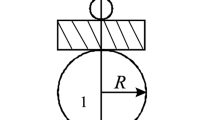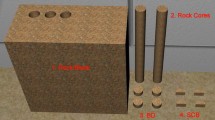Abstract
Granitic rocks usually exhibit strongly anisotropy due to pre-existing microcracks induced by long-term geological loadings. The understanding of the rock anisotropy in mechanical properties is critical to a variety of rock engineering applications. In this paper, Brazilian tests are conducted statically with a material testing machine and dynamically with a split Hopkinson pressure bar system to measure both static and dynamic tensile strength of Barre granite. To understand the anisotropy in tensile strength, samples are cored and labelled using the three principle directions of Barre granite to form six sample groups. For dynamic tests, a pulse shaping technique is used to achieve dynamic equilibrium in the samples during the dynamic test. The finite element method is then implemented to formulate equations that relate the failure load to the material tensile strength by employing an orthotropic elastic material model. For samples in the same orientation group, the tensile strength shows clear loading rate dependence. The tensile strengths also exhibit clear anisotropy under static loading while the anisotropy diminishes as the loading rate increases, which may be due to the interaction of pre-existing microcracks.










Similar content being viewed by others
References
Barla, G., Rock anisotropy: Theory and laboratory testing (L. Muller. Springer-Verlag, New York 1974).
Berenbaum, R., and Brodie, I. (1959), The tensile strength of coal., J. Inst. Fuel 32, 320–327.
Bieniawski, Z.T., and Hawkes, I. (1978), Suggested methods for determining tensile strength of rock materials, Int. J. Rock Mech. Min. Sci. 15, 99–103.
Bohme, W., and Kalthoff, J.F. (1982), The behavior of notched bend specimens in impact testing, Int. J. Fract. 20, R139–R143.
Cai, M., Kaiser, P.K., Suorineni, F., and Su, K. (2007), A study on the dynamic behavior of the Meuse/Haute-Marne argillite, Phys. Chem. Earth. 32, 907–916.
Chen, C.S., Pan, E., and Amadei, B. (1998), Determination of deformability and tensile strength of anisotropic rock using Brazilian tests, Int. J. Rock Mech. Min. Sci. 35, 43–61.
Coviello, A., Lagioia, R., and Nova, R. (2005), On the measurement of the tensile strength of soft rocks, Rock Mech. Rock Eng. 38, 251–273.
Dai, F., Xia, K.W., and Luo, S.N. (2008), Semi-circular bend testing with split Hopkinson pressure bar for measuring dynamic tensile strength of brittle solids, Rev. Sci. Instrum. 79.
Douglass, P.M., and Voight, B. (1969), Anisotropy of granites: a reflection of microscopic fabric, Geotechnique 19, 376–379.
Evans, I. (1961), The tensile strength of coal, Colliery Engi. 38, 428–434.
Frew, D.J., Forrestal, M.J., and Chen, W. (2001), A split Hopkinson pressure bar technique to determine compressive stress-strain data for rock materials, Exp. Mech. 41, 40–46.
Frew, D.J., Forrestal, M.J., and Chen, W. (2002), Pulse shaping techniques for testing brittle materials with a split Hopkinson pressure bar, Exp. Mech. 42, 93–106.
Goldsmith, W., Sackman, J.L., and Ewert, C. (1976), Static and dynamic fracture strength of Barre granite, Int. J. Rock Mech. Min. Sci. 13, 303–309.
Grady, D.E., and Hollenbach, R.E. (1979), Dynamic fracture strength of rocks, Geophys. Res. Lett. 6, 73–76.
Grady, D.E., and Kipp, M.E. (1980), Continuum Modelling of Explosive Fracture in Oil Shale, Int. J. Rock Mech. Min. Sci. & Geomech. Abstr. 17, 147–157.
Hobbs, D.W. (1964), The strength and the stress strain characteristics of coal in triaxial compression, J. Geol. 72, 214–231.
Hudson, J.A. (1969), Tensile strength and ring test, Int. J. Rock Mech. Min. Sci. 6, 91–97.
Hudson, J.A., Rummel, F., and Brown, E.T. (1972), The controlled failure of rock disks and rings loaded in diametral compression, Int. J. Rock Mech. Min. Sci. 9, 241–248.
Kipp, M.E., Grady, D.E., and Chen E.P. (1980), Strain rate dependent fracture initiation, Int. J. fracture. 16, 471–478.
Kolsky, H., Stress waves in solids (Clarendon Press, Oxford 1953).
Mclamore, R., and Gray, K.E. (1967), Mechanical behavior of anisotropic sedimentary rocks, J. Eng. Ind. 89, 62–67.
Mellor, M., and Hawkes, I. (1971), Measurement of tensile strength by diametral compression of discs and annuli, Eng. Geol. 5, 173–225.
Nasseri, M.H.B., and Mohanty, B. (2008), Fracture toughness anisotropy in granitic rocks, Int. J. Rock Mech. Min. Sci. 45, 167–193.
Nasseri, M.H.B., Mohanty, B., and Robin, P.Y.F. (2005), Characterization of microstructures and fracture toughness in five granitic rocks, Int. J. Rock Mech. Min. Sci. 42, 450–460.
Newmark, N.M, (1959), A method of computation for structure dynamics, J. Eng Mech. Division. ASCE, 85, 67–94.
Peng, S., and Johnson, A.M. (1972), Crack growth and faulting in cylindrical specimens of chelmsford granite, Int. J. Rock Mech. Min. Sci. 9, 37–86.
Phillips, W.J., and Phillips, N., An introduction to mineralogy for geologists (John Wiley & Sons Inc., New York 1980).
Sano, O., Kudo, Y., and Mizuta, Y. (1992), Experimental determination of elastic constants of Oshima granite, Barre granite, and Chelmsford granite, J. Geophys. Res.-Sol. Ea. 97, 3367–3379.
Schedl, A., Kronenberg, A.K., and Tullis, J. (1986), Deformation microstructures of Barre granite: an optical, SEM and TEM study, Tectonophysics 122, 149–164.
Schmidt, R.A., (1977), Fracture Mechanics of Oil Shale-Unconfined Fracture Toughness, Stress Corrosion Cracking and Tension Test Results, 18th U.S. Symposium on Rock Mechanics. Keystone, CO, 2A2-1.
Wang, Q.Z., Li, W., and Song, X.L. (2006), A method for testing dynamic tensile strength and elastic modulus of rock materials using SHPB, Pure Appl. Geophys. 163, 1091–1100.
Xia, K., Nasseri, M.H.B., Mohanty, B., Lu, F., Chen, R., and Luo, S.N. (2008), Effects of microstructures on dynamic compression of barre granite, Int. J. Rock Mech. Min. Sci. 45, 879–887.
Zhao, J., and Li, H.B. (2000), Experimental determination of dynamic tensile properties of a granite, Int. J. Rock Mech. Min. Sci. 37, 861–866.
Acknowledgments
This research is financially supported by the National Science and Engineering Research Counsel of Canada through Discovery Grant No. 72031326. The authors are grateful to the editor, Professor Yves Guéguen and two anonymous reviewers for their constructive comments and valuable time devoted to improving our manuscript.
Author information
Authors and Affiliations
Corresponding author
Rights and permissions
About this article
Cite this article
Dai, F., Xia, K. Loading Rate Dependence of Tensile Strength Anisotropy of Barre Granite. Pure Appl. Geophys. 167, 1419–1432 (2010). https://doi.org/10.1007/s00024-010-0103-3
Received:
Revised:
Accepted:
Published:
Issue Date:
DOI: https://doi.org/10.1007/s00024-010-0103-3




